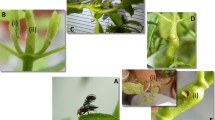Abstract
Hydrellia balciunasi Bock, a native of Australia, was evaluated in quarantine in Florida, USA, for its potential as a biocontrol agent of the submersed aquatic weed,Hydrilla verticillata (L.f) Royle. Larvae are leafminers. Mean total development time at 27°C was 22.8 days. Mean duration of the egg stage was 3.0 days, larval was 11.5 days, and puparial was 8.3 days. Mean fecundity was 35.5 eggs. Mean female longevity was 19.7 days, and mean male longevity was 15.6 days. The sex ratio was 1.1∶1 (male: female). Fourteen plant species closely related to hydrilla in 4 families plus rice were tested in no-choice larval development tests and an additional 27 plant species in 16 families were tested in multi-choice tests. Larvae mined in 2 test plant species,Potamogeton pusillus L. andP. crispus L., but developed (1%) only on the introduced weedP. crispus L. Females oviposited on most test plants. Permission to release this fly in the United States was received from federal and state (Florida) officials, and it was released from quarantine on 24 May 1989.
Résumé
Hydrellia balciunasi, originaire d'Australie, a été évaluée en quarantaine en Floride, pour déterminer ses potentialités comme agent de lutte biologique contre la mauvaise herbe aquatique,Hydrilla verticillata (L.f.) Royle. Les larves sont des mineuses des feuilles. La durée moyenne de développement de cette mouche était de 22,8 jours à une température de 27°C. La durée moyenne du stade œuf était de 3,0 jours. Le stade larvaire comptait en moyenne 11,5 jours et celui des pupes 8,3 jours. La fécondité moyenne était de 35,5 œufs. La moyenne de longévité de la femelle et du mâle était respectivement de 19,7 et de 15,6 jours. Le rapport mâle: femelle était 1.1∶1. En plus du riz, 14 espèces de plantes proches d'Hydrilla et appartenant à 4 familles ont été testées dans des essais de développement larvaire sans choix. En outre, 27 espèces de plantes appartenant à 16 familles étaient testées en essais de choix multiples. Les larves minaient seulement 2 espèces dePotamogeton et se développaient (1%) seulement surP. crispus L. qui est une mauvaise herbe introduite. Les femelles pondaient des œufs sur la majorité des plantes testées. L'autorisation de libérer cette mouche aux États-Unis a été obtenue du Gouvernement fédéral et de celui de l'État de Floride. La mouche fut libérée à partir de la quarantaine, le 24 mai 1989.
Similar content being viewed by others
References
Balciunas, J. & Center, T. — 1988. Australian insects to control hydrilla. In: Proceedings, 22nd Annu. Meet., Aquat. Plant Control Res. Program, 16–19 November 1987, Portland, Oregon. —U.S. Army Corps of Eng. Misc. Paper, A-88-5,Vicksburg, Mississippi, 312–319.
Balciunas, J. K. &Minno, M. C. — 1985. Insects damaging hydrilla in the USA.. —Journ. Aquat. Plant Manage., 23, 77–83.
Baloch, G. M., Sana-Ullah &Ghani, M. A. — 1980. Some promising insects for the biological control ofHydrilla verticillata in Pakistan. —Trop. Pest Manage., 26, 194–200.
Berg, C. O. — 1950.Hydrellia [Ephydridae] and some other acalyptrate Diptera reared fromPotamogeton. —Ann. Entomol. Soc. Amer., 43, 374–398.
Bock, I. — 1990. The Australian species ofHydrellia Robineau-Desvoidy [Diptera: Ephydridae]. —Invert. Taxon., 3, 965–993.
Buckingham, G. R. — 1988. Reunion in Florida-hydrilla, a weevil, and a fly. —Aquatics, 10, 19–25.
Buckingham, G. R., Okrah, E. A. & Thomas, M. C. — 1989. Laboratory host range tests withHydrellia pakistanae [Diptera: Ephydridae], an agent for biological control ofHydrilla verticillata [Hydrocharitaceae] —Environ. Entomol., 18, 164–171.
Deonier, D. L. — 1971 A systematic and ecological study of NearcticHydrellia [Diptera: Ephydridae]. —Smithsonian Contrib. Zool., 68, 1–147.
Deonier, D. L. — 1978. New species ofHydrellia reared from aquatic macrophytes in Pakistan [Diptera: Ephydridae]. —Entomol. Scand., 9, 188–197.
Ferino, M. P. — 1968. The biology and control of the rice leaf-whorl maggot,Hydrellia philippina Ferino [Ephydridae, Diptera]. —Philipp. Agr., 52, 332–383.
Grigarick, A. A. — 1959. Bionomics of the rice leaf miner,Hydrellia griseola (Fallen), in California [Diptera: Ephydridae]. —Hilgardia, 29, 1–80.
Krishnaswamy, S. &Chacko, M. J. — 1990.Hydrellia spp. [Diptera: Ephydridae] attackingHydrilla verticillata in South India. —Entomophaga, 35, 211–216.
SAS Institute, Inc. — 1985. SAS/STAT Guide for personal computers, Version 6 edition. —SAS Institute, Inc. Cary, North Carolina.
Steward, K. K., Van, T. K., Carter, V. &Pieterse, A. H. — 1984. Hydrilla invades Washington, D.C. and the Potomac. —Amer. J. Bot., 71, 162–163.
Tomoika, T. — 1983. Ecological note on two species ofHydrellia [Diptera: Ephydridae] —Annu. Rept. Plant Prot. North Japan, 34, 13–16. (Transl. byK. Hachiya).
Velayutham, B., Santhanaraman, T., Subramaniam, T. R. &Subramanian, A. — 1973. Life-history and control ofHydrellia sasakii Yuasa and Isitani [Diptera: Ephydridae], a new pest of rice crop in Tamil Nadu. —Madras Agric. J. 60, 210–213.
Author information
Authors and Affiliations
Rights and permissions
About this article
Cite this article
Buckingham, G.R., Okrah, E.A. & Christian-Meier, M. Laboratory biology and host range ofHydrellia balciunasi [Diptera: Ephydridae]. Entomophaga 36, 575–586 (1991). https://doi.org/10.1007/BF02374440
Received:
Accepted:
Issue Date:
DOI: https://doi.org/10.1007/BF02374440




